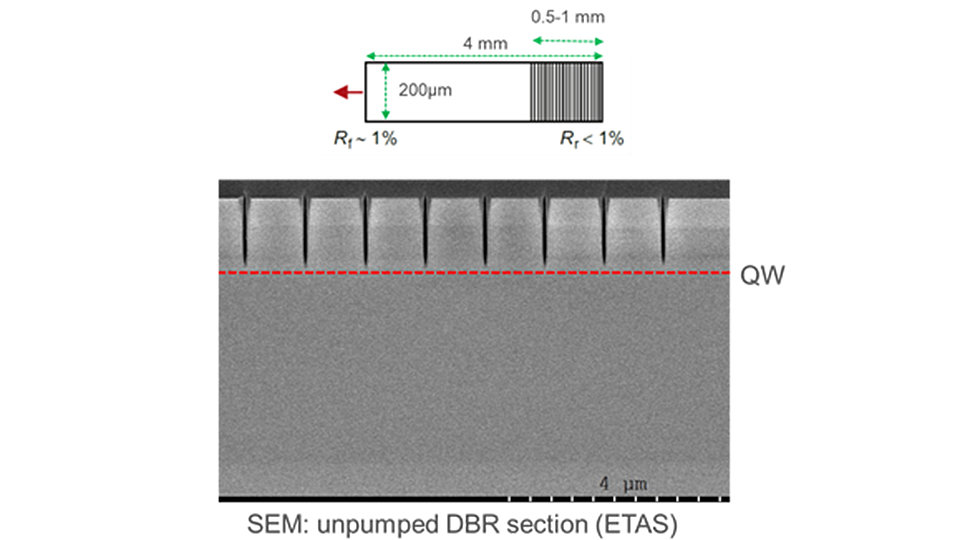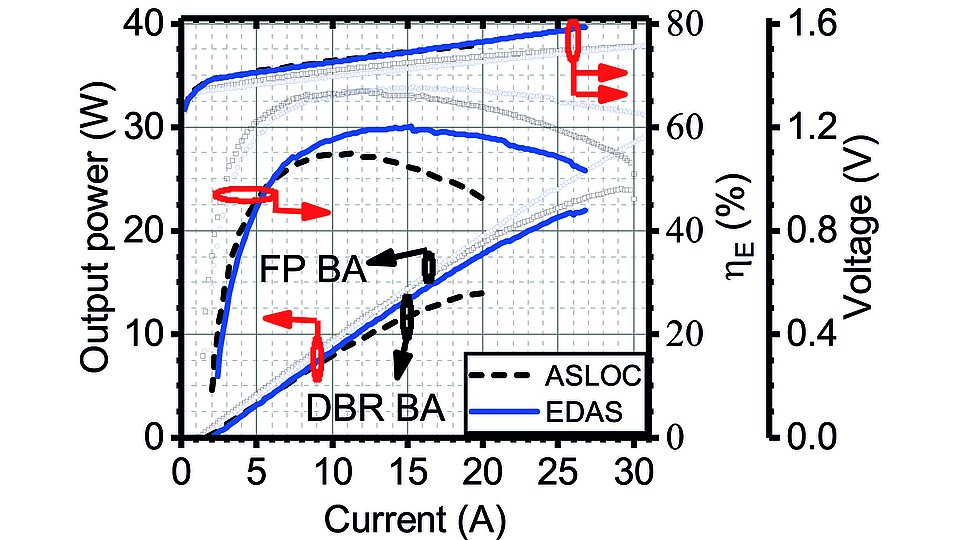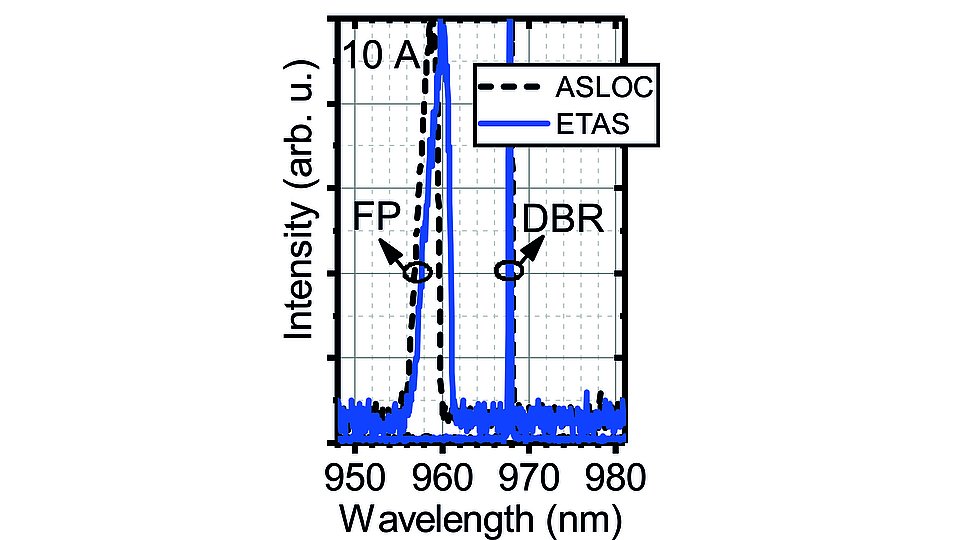Monolithic DBR-stabilized 970 nm broad-area diode lasers with 60 % power conversion efficiency
Fig. 1: (top) schematic top view of the DBR BA lasers and (bottom) a scanning microscope image of the DBR section of an ETAS DBR laser.
Fig. 2: PUI characteristics and ηE of the ASLOC (dashed) and ETAS (solid) based reference FP and DBR BA lasers in CW mode at THS = 25 °C.
Wavelength-stabilized diode lasers emitting at λ ~ 970…980 nm with narrow emission spectra are in high demand for pumping Yb-doped fiber and solid-state lasers. Conventional broad-area (BA) diode lasers with Fabry-Perot (FP) cavity deliver high power Popt (~ 10-20 W) at high conversion efficiency ηE (~ 60 - 65 %). However, they operate with very broad spectral linewidth Δλ95% > 3 nm, which broadens strongly with operating current Iopt, thus restricting their use in many applications. FBH scientists have recently succeeded in realizing efficient, wavelength-stabilized BA lasers. These lasers employ 7th order surface-etched monolithic distributed Bragg reflectors (DBRs), formed by electron beam lithography and subsequent reactive ion etching on fully grown epitaxial layer structures.
We have developed DBR BA lasers based on two different epitaxial designs, an asymmetric large optical cavity (ASLOC) and an extreme-triple-asymmetric (ETAS) layer structure, consisting of a single quantum well. The DBR lasers have a 200 µm wide stripe and a 4 mm long cavity with 0.5 - 1.0 mm long DBRs realized near the rear side of the cavity. In order to assess the impact of the DBRs on the lasing performance, reference FP BA lasers were also realized. Initially, we performed facet treatment with passivation and reflection coating with a reflectivity of Rf ~ 1 % at the front side and at the rear side with Rr < 0.1 % for the DBR and 98 % for the FP lasers. Then, the laser chips were soldered on expansion matched CuW heat spreader and subsequently mounted on a Cu block, acting as a passive heat-sink. A schematic top view of the DBR lasers and a scanning electron microscope image of the DBR section of a fully processed ETAS DBR laser are depicted in Fig. 1.
Fig. 2 shows the power-current-voltage (PUI) characteristics and ηE of the ASLOC and ETAS BA lasers in continuous-wave (CW) mode at THS = 25 °C heat-sink temperature. The ASLOC FP laser provides a peak Popt = 24 W, limited by strong power saturation at high bias. On the other hand, the ETAS-based FP BA laser delivers Popt ~ 30 W (still increasing) by mitigating the power saturation effects due to advanced highly asymmetric epitaxy (ETAS structure) [1, 2]. The ETAS FP laser also yields > 10 % higher ηE at Popt = 24 W (65 % vs 54 %). Consistent with the FP lasers, the ETAS DBR BA laser (LDBR = 1.0 mm) also provides a higher peak Popt (22 W vs. 14 W) and higher ηE at high bias current than the ASLOC counterparts. Efficiency of ηE = 60 % is obtained at Popt = 14 W in contrast to the ηE = 46 % of the ASLOC DBR laser. Overall, this represents the highest ever published combination of efficiency and power in a monolithically grating-stabilized laser.
Both the ASLOC and ETAS DBR lasers emit at centroid λ ~ 970 nm, defined by the DBR wavelength, with significantly (~ 4 - 5 times) reduced Δλ95% than the reference FP lasers as shown in Fig. 3. The ETAS DBR laser produces Δλ95% < 1 up to Popt ~ 20 W.
The investigated DBR BA lasers are therefore promising sources for applications that require high power, high efficiency, and stable emission with narrow linewidth. Further increase in power and efficiency is being sought at FBH by further optimizing the epitaxial layer structure, e.g. by ensuring higher modal gain and lower losses incurred by longitudinal spatial hole burning.
Publications
P. Crump, M. J. Miah, J. Fricke, M. Wilkens, S. Kreutzmann, H. Wenzel, and A. Knigge, “970 nm DBR broad-area semiconductor lasers with 60% conversion efficiency,” 27th International Semicond. Laser Conf. (ISLC), Potsdam, Germany, paper-WP3.6, 2021.
P. Crump, M. J. Miah, M. Wilkens, J. Fricke, H. Wenzel, and A. Knigge, “60% efficient monolithically wavelength-stabilized 970 nm DBR broad-area lasers,” IEEE Photonics Journal, 2022 (submitted).


